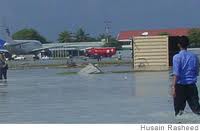Impacts of Sea-Level Rise in the Maldives


Impact problem
Small, low-lying islands have been seen as highly vulnerable to sea-level rise, particularly as many islands and remote and/or low-lying. The impacts of climate change on small islands – specifically the Maldives – is being assessed in the IMPACT2C project, which aims to quantify the impacts and costs of climate change given a 2ºC rise in temperatures with respect to pre-industrial levels. The Maldivian study is being led by the University of Southampton, UK, with partners at Global Climate Forum and HZG Germany and the Ministry for Environment and Energy in the Maldives.
Lying in the Indian Ocean, the Maldives is comprised 1,192 low-lying coral atoll islands. 200 of the islands are inhabited, with the highest population density found in the capital city, Malé. The islands are economically dependent on tourism and fisheries, so it is important that they are able to maintain these industries and adapt as the climate changes. However, rising sea levels are just one problem as in some islands – including the capital – land is under great pressure from a large and growing population. Subsequently this project investigates the impacts of the combined effect of high population growth and sea-level rise. Adaptation options from the present day, as well as potential future options will be investigated.
(0) Comments
There is no content